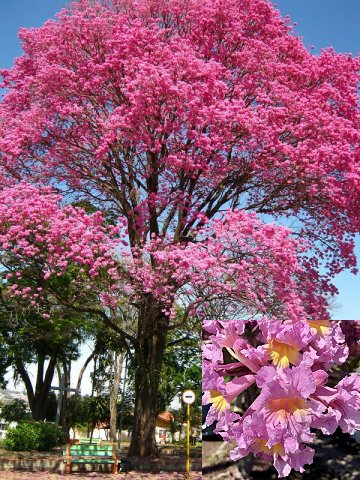
|
|
Pink Lapacho
(Handroanthus impetiginosus). Flowers.
|
Pink Lapacho - Handroanthus impetiginosus
Handroanthus impetiginosus, the pink ipê, pink lapacho or pink trumpet tree, is a tree in the family Bignoniaceae, distributed throughout North, Central and South America, from northern Mexico south to northern Argentina. Along with all the other species in the Handroanthus genus, it is the national tree of Paraguay.
The species is native to north-eastern Argentina, Bolivia, Brazil, Colombia, Costa Rica, El Salvador, French Guyana, Guatemala, Honduras, central and southern Mexico, Nicaragua, Panama, Paraguay, Peru, Surinam and Venezuela, where it grows in the deciduous forests as well as in the pluvial ones up to about 1400 m of altitude.
The name of the genus is the combination of the name of the Brazilian botanist Oswaldo Handro (1908-1986) and of the Greek term “anthos” = flower; the name of the species comes from the Latin “impetigo, inis” = impetigo (a skin disease), in fact, they thought that the plant might treat this disease.
It is a rather large deciduous tree, with trunks sometimes reaching 80 cm (31 in) in width and 30 m (98 ft) in height. Usually a third of that height is trunk, and two thirds are its longer branches. It has a large, globous, but often sparse canopy. The tree has a slow growth rate. Leaves are opposite and petiolate, 2 to 3 inches long, elliptic and lanceolate, with lightly serrated margins and pinnate venation. The leaves are palmately compound with usually 5 leaflets.
Its bark is brownish grey, tough and hard to peel. The wood is of a pleasant yellowish colour, barely knotted and very tough and heavy (0,935 kg/dm³). It's rich in tannins and therefore very resistant to weather and sun. It is not very useful for furniture since it is so hard to work by hand. It can be found as beams or fulfilling other structural uses where needed outdoors.
In the southern hemisphere, pink lapacho flowers between July and September, before the new leaves appear. The flower is large, tubular shaped, its corolla is often pink or magenta, though exceptionally white, about 2 in (5.1 cm) long. There are four stamens and a staminode.
The flowers are easily accessible to pollinators. Some hummingbirds - e.g. black jacobin (Florisuga fusca) and black-throated mango (Anthracothorax nigricollis) - seem to prefer them over the flowers of other Handroanthus species, while for others like the stripe-breasted starthroat (Heliomaster squamosus) it may even be a mainstay food source.
The fruit is a coriaceous, glabrous, dehiscent (spontaneously opening when ripe), capsule, cylindrical, 25-40 cm long and 1,5-2 cm broad, containing several flat winged seeds, 2,5-5 cm long and 1-1,5 cm (wings included) broad, which are dispersed by the wind.
Handroanthus impetiginosus is used as a honey plant, and widely planted as an ornamental tree in landscaping gardens, public squares and boulevards due to its impressive and colorful appearance as it flowers. Well-known and popular, it is the national tree of Paraguay. It is also planted as a street tree in cities of India, like in Bengaluru.
The inner bark is used in traditional medicine. It is dried, shredded, and then boiled, making a bitter brownish-colored tea known as lapacho or taheebo. The unpleasant taste of the extract is lessened when taken in pill form, or as tinctures. Lapacho bark is typically used during flu and cold season and for easing smoker's cough. It is claimed to work by promoting the lungs to expectorate and free deeply embedded mucus and contaminants during the first three to ten days of treatment.
The heartwood contains a naphthaquinone called lapachol - this has been shown to have antibiotic and antitumor effects.
However, the main active compound lapachol has since turned out to be toxic enough
Many native S. American peoples have prized pau d'arco as a cure-all, using it to treat a wide range of conditions including wounds, fevers, dysentery, intestinal inflammation and snake bites. In modern herbalism the bark is used internally in the treatment of inflammatory diseases, chronic degenerative diseases, cancers, tumours, cysts, fungal infections (especially candidiasis), venereal diseases, rheumatic diseases, skin problems (especially eczema, herpes and scabies).
It is also used, in combination with other herbs, to clear toxins, resolve congestion and strengthen the immune system. The wood is harvested as required and dried for later use.
The timber, known as lapacho, is highly valued
A very durable and strong wood, it has a very wide range of uses, especially for outdoor applications. It is used for making high class furniture, cabinet work, heavy construction, railway sleepers, bridges, hydraulic works, industrial flooring, posts and poles, turnery, musical instruments, tool handles, veneer etc.
Source:
https://en.wikipedia.org/wiki/Handroanthus_impetiginosus
https://pfaf.org/User/Plant.aspx?LatinName=Handroanthus+impetiginosus
https://www.monaconatureencyclopedia.com/handroanthus-impetiginosus/?lang=en
